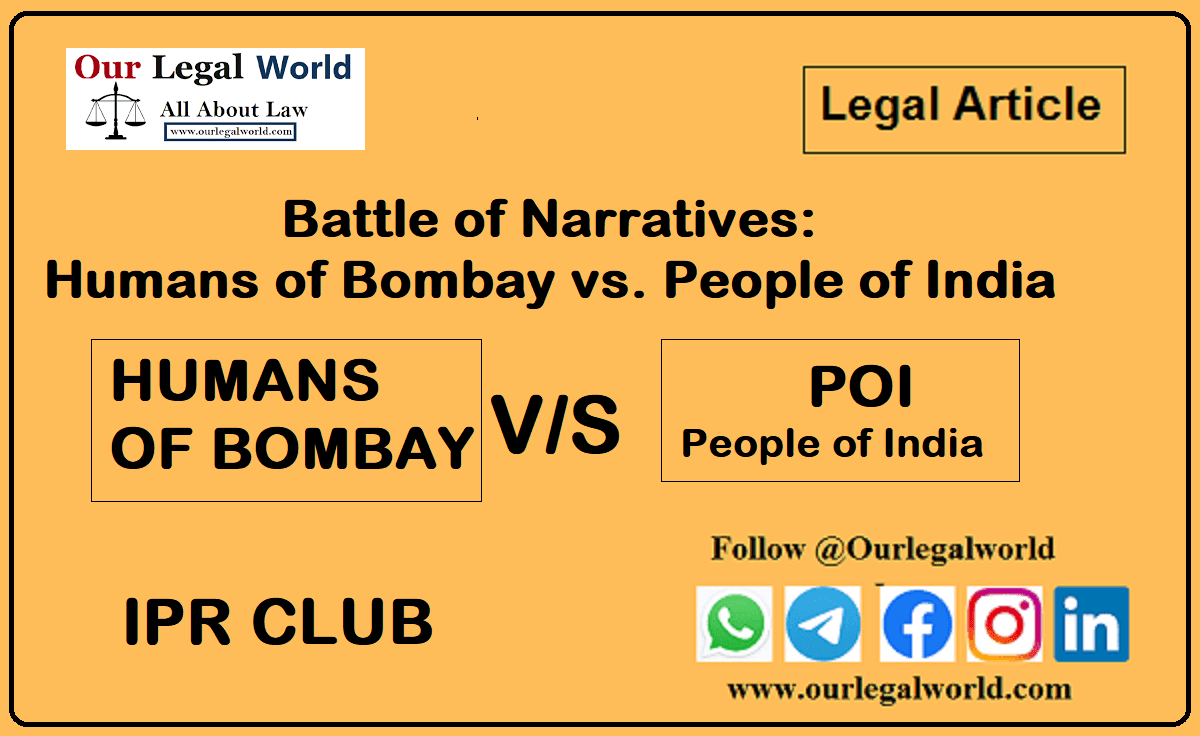Battle of Narratives: Humans of Bombay vs. People of India
Written by Harshita Sakariya & Khushboo Pachisia
Introduction
In the realm of digital storytelling, a legal battle is brewing, and it’s a tale of two platforms – Humans of Bombay (HOB) and People of India (POI). The lawsuit originated from Humans of Bombay’s claim, that People of India had duplicated its distinctive storytelling format and published identical content. POI had incorporated images and videos from the former’s platform without obtaining permission, which was a central grievance in HOB’s case.
Before delving deeper into the legality of this matter, it is essential to provide a clearer and more comprehensive background.
In January 2014, Karishma Mehta initiated Humans of Bombay, a project inspired by Humans of New York, both aimed to authentically capture and disseminate people’s stories, challenges, and triumphs in their respective cities. She embarked on a journey across Mumbai, engaging people in conversations about their life experiences and gaining their consent to share their stories and photos on her website. People of India, the defendant in this case, is another such platform out of the many that showcases narratives of Indians living worldwide.
The Plaintiff’s Position: Humans of Bombay
The Plaintiff prima facie argued that the Defendants have not only emulated their platform but have also replicated a substantial number of images and videos, incorporating them into their own. HOB claims that they conduct extensive research and proactively reach out to individuals who are willing to share their life stories. These narratives are then transformed into audio-visual content which was subsequently posted on their designated website and related platforms.
The Plaintiff contends that their team and commissioned writers are responsible for crafting the written content in the stories, encompassing summaries, captions, and scripts. They maintain ownership of the copyrights to these works. Before publication, the Plaintiff diligently secures written consent from the individuals’ featured, establishing a contractual agreement restricting others from sharing the subject’s story for a defined period. HOB sought for an injunction against the Defendants’ website and activities for infringement on their creative territory.
The Defendant’s Stand: People of India
The Defendant’s counsel counter-argued, that the resemblance in certain images might be attributed to the fact that the individuals featured in the stories themselves might have supplied these images to both parties independently. Furthermore, they contend that Plaintiff themselves have engaged in similar copying practices, citing instances where Plaintiff duplicated certain images from Defendant’s website as well as content that was published by a third party, thus diminishing the grounds for copyright claims in those cases.
Additionally, the Defendant’s counsel argues that all these platforms, including the Plaintiff’s, have drawn inspiration from the original platform, Humans of New York, and therefore, the concept is not truly unique.
Judgement
On October 11, 2023, the Hon’ble Delhi High Court upheld the legal principle reiterating the crucial distinction between ideas and expressions. The Judgement talks about the age-old concept known as the idea-expression dichotomy. In a nutshell, it means you can’t copyright an idea itself, but you can certainly protect how that idea is expressed.
This Single Bench led by Prathiba M. Singh, J., concluded that neither of the platforms would be entitled to replicate or imitate each other’s digital content or literary content. Both the platforms, Humans of Bombay and People of India shall refrain from using each other’s copyrighted works i.e., (1) commissioned photographs; (2) literary works such as interviews scripts and original pieces written authors on the respective platforms; (3) videos that may have been commissioned by the platforms themselves; (4) the manner of presentation of the stories published by the platforms in respect of a particular subject.
In the context of the present suit, the idea at the core is of a storytelling platform. There can be no monopoly over the running of such a platform. However, all such platforms that share stories about various individuals/subjects would be attaching/incorporating their own creative ways to communicate and disseminate the said stories, which constitute the expression.
Why is this Judgement important?
Imagine a world where every idea is safeguarded by copyright; it sounds impractical, doesn’t it? That’s because it is. The Delhi High Court has delivered a refreshing and unambiguous stance on a critical issue. This case has brought to the forefront several essential matters, but most notably, it has resolved the question of whether ideas can be copyrighted.
The Power of Ideas and Expressions
The “idea-expression dichotomy” is a fundamental concept in copyright law that distinguishes between ideas and the expression of those ideas. It is vital because copyright law protects the way ideas are expressed but not the ideas themselves. An idea is a thought, or mental impression, an underlying concept, such as the idea of a love story, a detective solving a crime, or a recipe for a delicious dish. Ideas are considered general and not subject to copyright protection. Whereas expression refers to the specific, tangible form in which an idea is presented. It encompasses the actual words, sentences, images, sounds, or other creative elements used to convey the idea. This is what copyright law is designed to protect.
In the context of this specific case, the core idea revolves around a storytelling platform. Platforms that share stories about different individuals, and they all incorporate their own creative methods to convey and disseminate these stories, which constitute the expression. So, who owns the copyright? Well, that depends on the creator of the content. If the platform commissioned photographs or videos, they possess the copyright. However, if the content originated from the subjects themselves, like personal photographs, then the copyright belongs to them. Multiple platforms cannot assert rights over the same content.
Also Read: Copyright Infringement of Songs in Weddings:- IPR Club
Ownership over a Business Platform?
In its wisdom, the court recognized that no one can claim monopoly on running such a platform because, at its foundation, it is the concept of storytelling, which is available to all and it is evident that the idea itself is not unique.
Multiple platforms are built around the concept of storytelling, and it is perfectly normal for different entities to independently explore this idea. The elements such as images, literary content, and distinct narrative styles are the intellectual property of the platform. The line that separates them lies in the uniqueness of these expressions. In simpler terms, you can’t simply replicate their creative work and claim it as your own. Such an action is a clear violation of copyright law.
Furthermore, the strength of these platforms lies in their community of loyal readers and followers that is the reputation they’ve build over the years. These individuals associate the content with a specific source or brand. Reading the same story on a different platform would be akin to picking up a different book by a different author. It doesn’t constitute misrepresentation unless the content or the story itself is copied, which would indeed constitute copyright infringement.
The Online Battle
When two internet-based platforms dedicated to sharing heartwarming human stories found themselves embroiled in a public dispute over the rights of storytellers and the potential involvement of legal actions, it triggered a widespread outpouring of opinions on social media.
Statement of Humans of New York
In response to the lawsuit, Brandon Stanton, the creator of the Humans of New York page, expressed his disapproval. On September 23, he took to the social media platform X to share his thoughts.
“I’ve stayed quiet on the appropriation of my work because I think @HumansOfBombay shares important stories, even if they’ve monetised far past anything I’d feel comfortable doing on HONY. But you can’t be suing people for what I’ve forgiven you for.”
The founder of Humans of Bombay in its response to the above tweet stated, that they have been inspired by HONY, however, the legal case, was not about inspiration, but in fact, about “substantial imitation”.
The aftermath of the Court’s verdict led to both platforms using their Instagram handles to declare victory, offering seemingly one-sided statements. However, it was the response from Karishma Mehta, the founder of Humans of Bombay, that notably drew attention. Mehta’s statement, thanking the Delhi High Court, for upholding their contentions and passing a permanent injunction, restraining POI from plagiarizing their literary works and creative expressions present a partial perspective. The essence of the Court’s ruling appears to center on both platforms being restricted from using each other’s content. So, does the difference in how the verdict has been presented raise doubts about a manipulated public narrative?
Although a relatively fairer statement was given by the People of India, by not only questioning the one-sided narrative offered by HOB but also simplifying the Court’s ruling. Even though their posts majorly talk about their side of the story the narrative does seem to be a little less altered for the original version.








